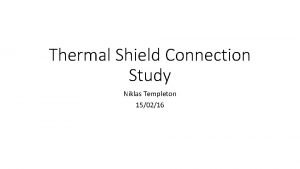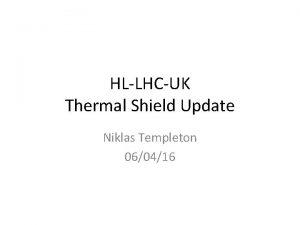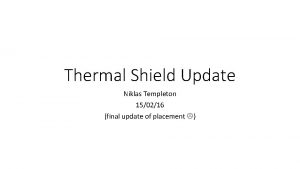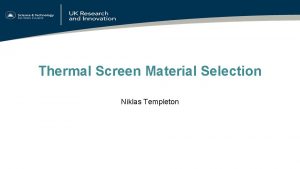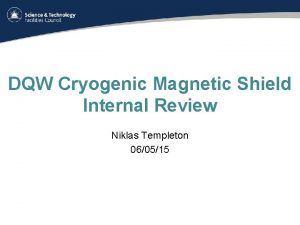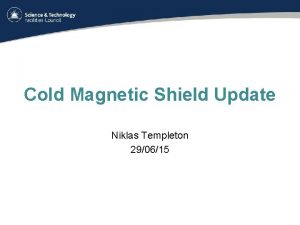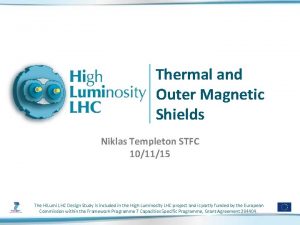Thermal Shield Support Analysis Niklas Templeton 280716 1








- Slides: 8

Thermal Shield Support Analysis Niklas Templeton 28/07/16 1

Requirements & Specification • 4 point flexure support aligned to central point • Deflection of up to 3. 3 mm • Shield Mass: ~180 kg • Design based on ISOLDE flexure mounts with similar top plate geometry. • Analysis to validate design, material, thickness and optimise for stiffness, manufacture and assembly. OFHC Copper Expansion Coefficient RT-50 K = 0. 32% d. L = 2094 x 0. 0032 = 6. 7 mm d. W = 730 x 0. 0032 = 2. 3 mm 730 m mm m 94 0 2 Preliminary Deflection Analysis Vacuum Vessel Interface Fixed & RT Thermal Shield 50 K 2

Initial Design & Analysis Material Properties UTS (MPa) 586 950 Boundary Conditions • Fixed at Vacuum Vessel interface • 3. 3 mm displacement at Thermal Shield interface • 900 N Shield weight 10 0 m m St. Steel 304 L Ti 6 Al 4 V (Gr 5) Annealed Modulus 0. 2% YS (GPa) (MPa) 193 241 114 880 Free Length 49 mm Brackets: St. Steel 304 L Flexure: Ti 6 AL 4 V Thickness: 1 mm 3

Flexure Deflection & Stress • Calculations 3. 3 δ (mm) 114 E (GPa) 100 b (mm) 49 l (mm) 1 d (mm) I (mm 4) 8. 33 Z (mm 3) 16. 67 310. 1 470. 1 W (N) S (MPa) 4

Flexure Thickness Sweep t (mm) 1 0. 9 0. 8 0. 7 0. 6 Ti Stress 455 410 364 319 273 0. 5 228 Decreasing the flexure thickness from 1 to 0. 5 mm reduces the maximum stress by half. Flexure stress << yield strength at RT (880 MPa) thickness reduction is not necessary even when including shield weight. 1 mm flexure thickness is suitable for Ti-6 AL-4 V 5

Material Comparison Titanium vs. Stainless Steel Flexure An all SS bracket could be advantageous however, due to the much lower yield strength of SS 304 L, and the deflection required, a SS flexure of thickness <0. 3 mm would be necessary, which causes various issues with system stiffness, buckling, manufacture & assembly etc. Titanium flexure is required. 6

Width Sweep – Modal Comparison Investigating the effect of increasing/decreasing the flexure width on system stiffness using modal analysis tools. Increasing flexure width improves stiffness (I & Z) of the support system without effecting the deflection stress. Results show no improvement to modal behaviour. Conclusion Shield body modes dominate. Shield support modes are sufficiently high not to be seen in this analysis. Flexures wider than 100 mm could cause integration issues. Mode 1 2 3 4 5 6 7 8 9 10 11 12 13 14 15 16 17 18 19 20 21 22 23 Blade Width (mm) 50 100 150 Freq. (Hz) 17. 7 15. 4 15. 5 19. 1 17. 3 15. 8 19. 3 17. 5 17. 3 20. 7 18. 8 17. 4 21. 3 20. 4 20. 2 22. 5 21. 7 20. 4 28. 9 27. 5 27. 6 30. 4 30. 6 30. 0 30. 7 32. 0 31. 9 32. 8 32. 5 34. 5 32. 7 35. 3 33. 7 33. 0 35. 5 35. 1 33. 7 37. 1 38. 1 34. 8 37. 5 38. 4 34. 9 40. 9 38. 7 35. 1 41. 1 39. 7 37. 4 41. 8 41. 2 39. 2 42. 5 43. 6 43. 4 44. 1 43. 5 44. 4 46. 8 43. 7 45. 1 47. 7 43. 9 45. 6 49. 5 47. 4 50 mm 100 mm 150 mm 7

Design for Manufacture Increased Fastening Modified vessel bracket Other Modifications 8









